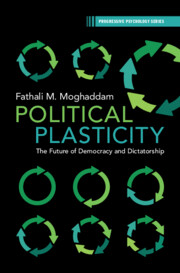Book contents
- Political Plasticity
- The Progressive Psychology Book Series
- Political Plasticity
- Copyright page
- Dedication
- Contents
- Figures
- Preface
- Acknowledgments
- Chapter 1 Political Plasticity, the Key to Understanding the Future of Democracy and Dictatorship
- Chapter 2 Hardwiring inside and outside People
- Part I Political Plasticity and Behavioral Continuity
- Part II Change Agents, in Theory and Practice
- Chapter 8 Revolutions and Political Plasticity
- Chapter 9 War as Transformative
- Chapter 10 Technology Forces Change
- Chapter 11 Globalization and Deglobalization
- Part III Looking Ahead
- Notes
- References
- Index
Chapter 11 - Globalization and Deglobalization
from Part II - Change Agents, in Theory and Practice
Published online by Cambridge University Press: 15 January 2023
- Political Plasticity
- The Progressive Psychology Book Series
- Political Plasticity
- Copyright page
- Dedication
- Contents
- Figures
- Preface
- Acknowledgments
- Chapter 1 Political Plasticity, the Key to Understanding the Future of Democracy and Dictatorship
- Chapter 2 Hardwiring inside and outside People
- Part I Political Plasticity and Behavioral Continuity
- Part II Change Agents, in Theory and Practice
- Chapter 8 Revolutions and Political Plasticity
- Chapter 9 War as Transformative
- Chapter 10 Technology Forces Change
- Chapter 11 Globalization and Deglobalization
- Part III Looking Ahead
- Notes
- References
- Index
Summary
Globalization seemed like an irresistible, unstoppable force. Political plasticity seemed to be pushed to higher levels, as globalization accelerated and impacted all humankind. The development of larger units such as the European Union signaled, for many, the end of the nation state – a borderless world. Economic and technological forces seemed to be forcing globalization, and all humankind, down a one-way road. On closer examination, however, we realize that globalization has been taking place in a fractured manner: Just as economic and technological forces have been pushing us toward the global, basic identity needs have been pulling us back toward the local. Thus, just as Europe is integrating, there is Brexit and Basque and Scottish independence. Just as the North American Free Trade Agreement comes into place, there is Quebec nationalism and the effort by Quebec nationalists to break away from the rest of Canada. The deglobalization movement has been accelerated by the rise of authoritarian strongmen and their extremist nationalist supporters. As this chapter shows, it seems that basic identity needs and allegiances to local groups and nations have influenced developments, so that political plasticity remains limited in this domain.
Keywords
- Type
- Chapter
- Information
- Political PlasticityThe Future of Democracy and Dictatorship, pp. 128 - 140Publisher: Cambridge University PressPrint publication year: 2023



